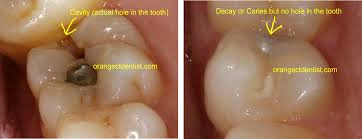Cavities, or tooth decay, is the destruction of your tooth enamel, the hard, outer layer of your teeth. It can be a problem for children, teens and adults. Plaque, a sticky film of bacteria, constantly forms on your teeth. When you eat or drink foods containing sugars, the bacteria in plaque produce acids that attack tooth enamel. The stickiness of the plaque keeps these acids in contact with your teeth and over time the enamel can break down. This is when cavities can form. A cavity is a little hole in your tooth.

Cavities are more common among children, but changes that occur with aging make cavities an adult problem, too. Recession of the gums away from the teeth, combined with an increased incidence of gum disease, can expose tooth roots to plaque. Tooth roots are covered with cementum, a softer tissue than enamel. They are susceptible to decay and are more sensitive to touch and to hot and cold. It’s common for people over age 50 to have tooth-root decay.
Decay around the edges, or a margin, of fillings is also common for older adults. Because many older adults lacked benefits of fluoride and modern preventive dental care when they were growing up, they often have a number of dental fillings. Over the years, these fillings may weaken and tend to fracture and leak around the edges. Bacteria accumulate in these tiny crevices causing acid to build up which leads to decay.
You can help prevent tooth decay by following these tips:
- Brush twice a day with a fluoride toothpaste.
- Clean between your teeth daily with floss or interdental cleaner.
- Eat nutritious and balanced meals and limit snacking.
- Check with your dentist about the use of supplemental fluoride, which strengthens your teeth, and about use of dental sealants (a plastic protective coating) applied to the chewing surfaces of the back teeth (where decay often starts) to protect them from decay.
- Visit your dentist regularly for professional cleanings and oral examination

